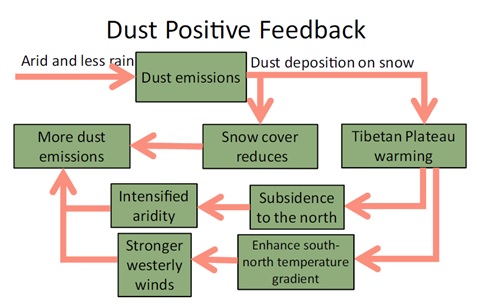Dust in snow on the Tibetan Plateau (TP) could reduce the visible snow albedo by changing surface optical properties and removing the snow cover through increased snowmelt, which leads to a significant positive radiative forcing and remarkably alters the regional energy balance and the eastern Asian climate system. Hence, the corresponding research had become an important hotspot in the field of climate change in Asia.
Dr. XIE Xiaoning, from Institute of Earth Environment, Chinese Academy of Sciences, collaborated with his colleagues, extended the previous investigation in dust-radiation interactions to investigate the dust-in-snow radiative forcing (SRF) and its feedbacks on the regional climate and the dust cycle over eastern Asia through the use of the CAM4-BAM model.
Our results showed that SRF increases the eastern Asian dust emissions significantly by 13.7% in the spring, countering a 7.6% decrease in the regional emissions by the dust direct radiative forcing (DRF). SRF also remarkably affected the whole dust cycle, including transport and deposition of dust aerosols over eastern Asia. The simulations indicated an increase in dust emissions of 5.1%, due to the combined effect of DRF and SRF. Further analysis revealed that these results were mainly due to the regional climatic feedbacks induced by SRF over eastern Asia. By reducing the snow albedo over the TP, the dust in snow mainly warmed the TP and influenced its thermal effects by increasing the surface sensible and latent heat flux, which in turn increased the aridity and westerly winds over northwestern China and affected the regional dust cycle. Additionally, the dust-in-snow also accelerated the snow-melting process, reduced the snow cover and then expanded the eastern Asian dust source region, which resulted in increasing the regional dust emissions. Hence, a significant feature of SRF on the TP is the creation of a positive feedback loop that affected the dust cycle over eastern Asia (Fig. 1).
This study was recently published in Atmospheric Chemistry and Physics. The work was mainly funded by National Key Research and Development Program of China (2016YFA0601900).

Fig.1 A schematic depiction of the feedback mechanism between dust emission and dust-in-snow radiative forcing.(Image by Xie, et al.)
Contact: Bai Jie, Institute of Earth Environment, Chinese Academy of Sciences, Xi'an, China. Email:baijie@ieecas.cn
 © 2015 Institute of Earth Environment,CAS
© 2015 Institute of Earth Environment,CAS Address:No. 97 Yanxiang Road, Xi'an 710061, Shaanxi, China

 Location :
Location :